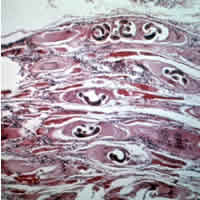Trichinosis
Trichinosis, also known as trichinellosis or trichiniasis, is a parasitic disease caused by roundworms of the Trichinella type. It primarily results from eating undercooked meat containing Trichinella cysts. This condition is frequently seen in North America, with bear meat as a common source, but it can also occur from consuming pork, boar, and dog meat.

Signs and Symptoms
The majority of trichinosis infections are either minor or asymptomatic. The infection can be divided into two main phases: enteral (intestinal) and parenteral (outside the intestines).
Enteral Phase
Symptoms in this phase might include nausea, heartburn, dyspepsia, and diarrhoea, typically occurring 2-7 days post-infection. A large burden of adult worms in the intestines may exacerbate these symptoms, while smaller burdens are generally asymptomatic. Eosinophilia presents early and increases rapidly.
Parenteral Phase
Symptoms during the parenteral phase depend on the number of larvae produced. Larval migration induces an inflammatory response, leading to oedema, muscle pain, fever, and weakness. A hallmark sign is periorbital oedema (swelling around the eyes), often caused by vasculitis. Splinter haemorrhage in the nails is also common. Severe cases may involve neurological deficits, such as ataxia or respiratory paralysis. Fatal outcomes are usually due to myocarditis, encephalitis, or pneumonia, occurring 4-6 weeks after infection.
Cause


The classical agent of trichinosis is T. spiralis, which infects a variety of carnivorous and omnivorous animals worldwide, including humans. Other species, such as T. britovi and T. nativa, also infect humans. After ingestion, the larvae are released in the stomach, invade the small intestine wall, and develop into adult worms. Female worms release larvae that migrate to skeletal muscle cells and form cysts.
Diagnosis
Diagnosis is confirmed through a combination of exposure history, clinical presentation, and laboratory testing. Epidemiological investigations help determine exposure to raw infected meat. Clinical diagnosis considers symptoms such as eye puffiness, splinter haemorrhage, and muscle pain. Laboratory tests include a complete blood count for eosinophilia and immunoassays like ELISA for larval antigens.
Prevention
Prevention strategies include cooking meat thoroughly, with a food thermometer to ensure the internal temperature is sufficient to kill larvae. Educational efforts focus on the risks of consuming raw or undercooked meat. Hunters are educated about the risks associated with wild game. Meat testing and legislative measures improve food safety. For instance, the USDA provides guidelines for farm and slaughterhouse inspections.
Treatment
Early treatment is very important and involves the administration of anthelmintics such as mebendazole or albendazole to prevent larval encystation. Steroids like prednisone may be used to alleviate muscle pain during larval migration. Ongoing research is looking at the development of vaccines using larval extracts and other antigenic materials, with promising results in experimental mouse studies.
Vaccine Research
Efforts to develop a vaccine for Trichinella include using larval extracts, excretory-secretory antigen, DNA, or recombinant antigen protein. Experimental studies have shown potential in reducing larval counts and preventing the establishment of new infections.
Epidemiology

Worldwide, approximately 10,000 infections occur annually, with notable cases in the United States, China, Argentina, and Russia. The incidence has decreased significantly in developed countries due to improved food safety measures and public awareness. However, developing countries still report higher cases due to less stringent food safety practices.
Self-assessment MCQs (single best answer)
What is the primary cause of trichinosis?
Which type of meat is a common source of trichinosis in North America?
What is the hallmark sign of the parenteral phase of trichinosis?
What is the primary method for diagnosing trichinosis?
Which anthelmintic drugs are used in the treatment of trichinosis?
What is a common symptom during the enteral phase of trichinosis?
Which of the following is NOT a species of Trichinella known to infect humans?
How can trichinosis be prevented?
What kind of laboratory test is used to detect larval antigens in trichinosis?
What severe complications can arise from untreated trichinosis?
Dentaljuce
Dentaljuce provides Enhanced Continuing Professional Development (CPD) with GDC-approved Certificates for dental professionals worldwide.
Founded in 2009 by the award-winning Masters team from the School of Dentistry at the University of Birmingham, Dentaljuce has established itself as the leading platform for online CPD.
With over 100 high-quality online courses available for a single annual membership fee, Dentaljuce offers comprehensive e-learning designed for busy dental professionals.
The courses cover a complete range of topics, from clinical skills to patient communication, and are suitable for dentists, nurses, hygienists, therapists, students, and practice managers.
Dentaljuce features Dr. Aiden, a dentally trained AI-powered personal tutor available 24/7 to assist with queries and provide guidance through complex topics, enhancing the learning experience.
Check out our range of courses, or sign up now!


